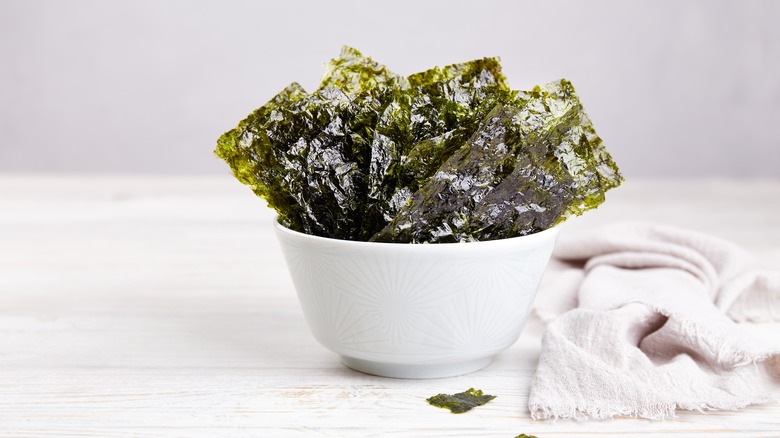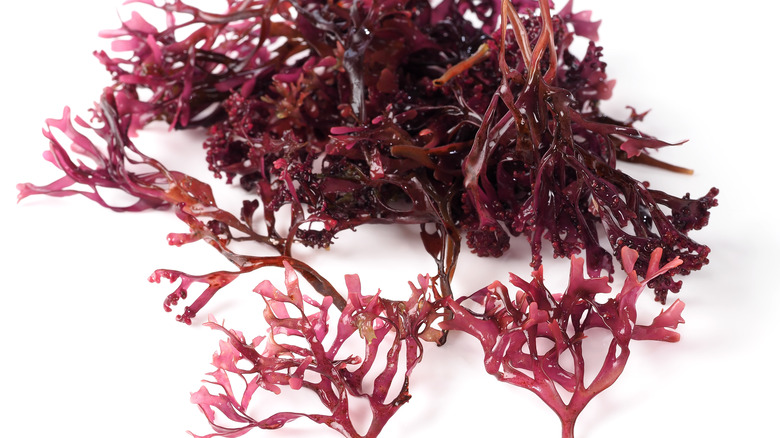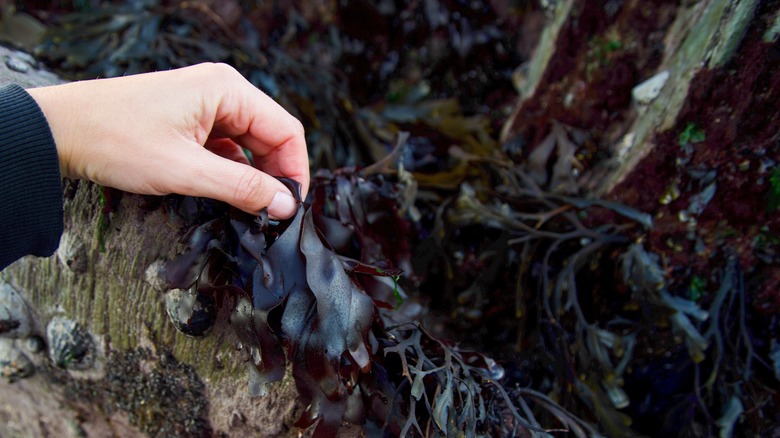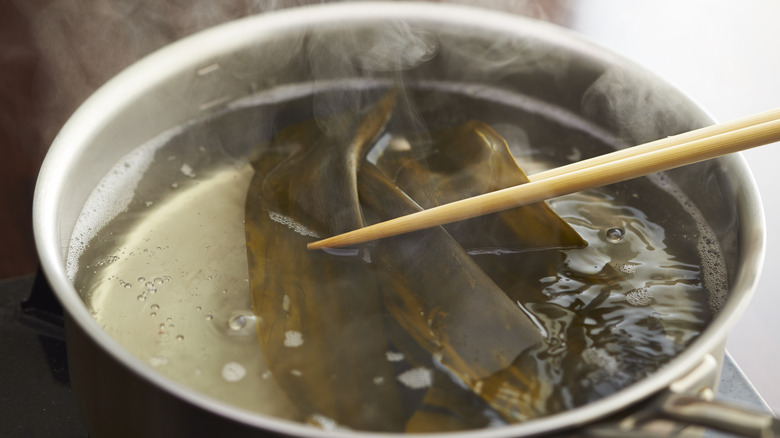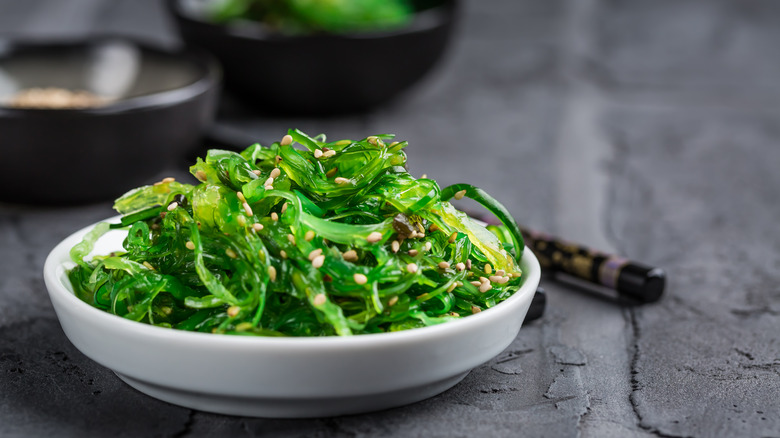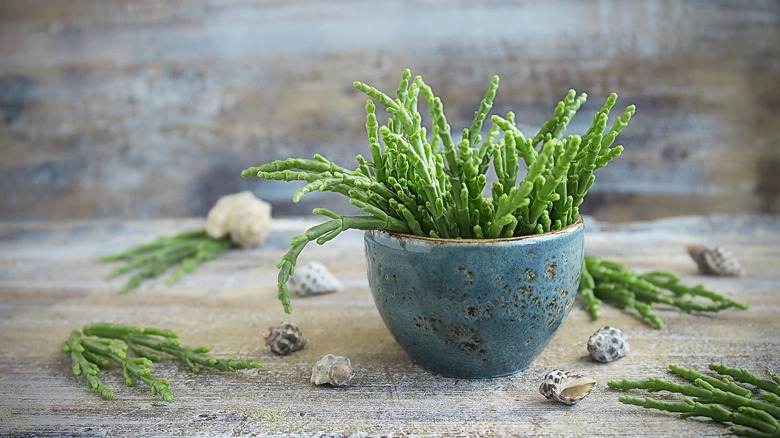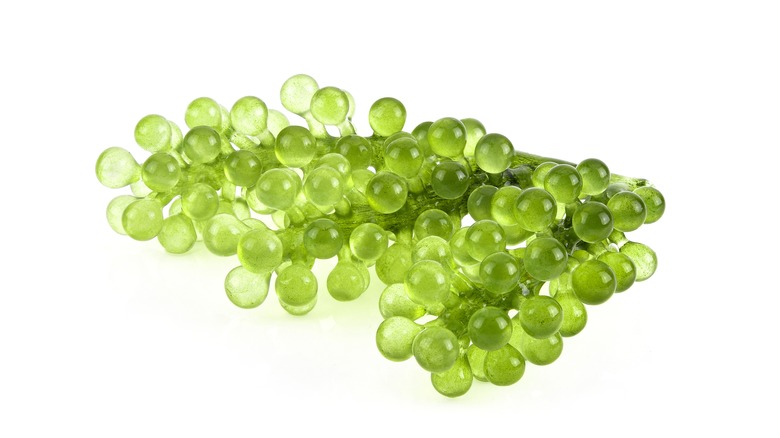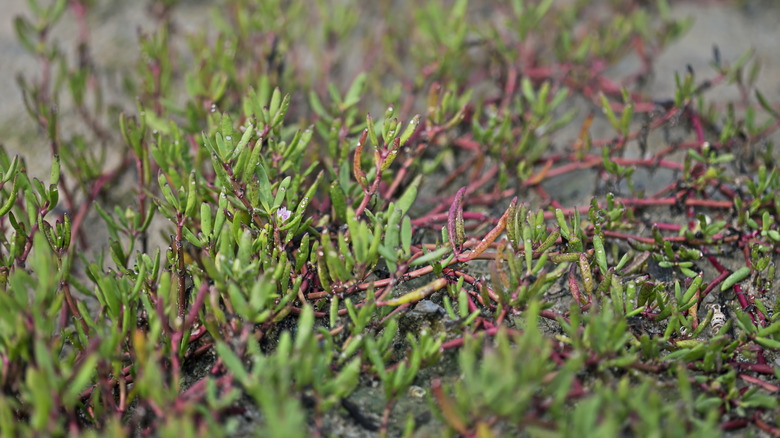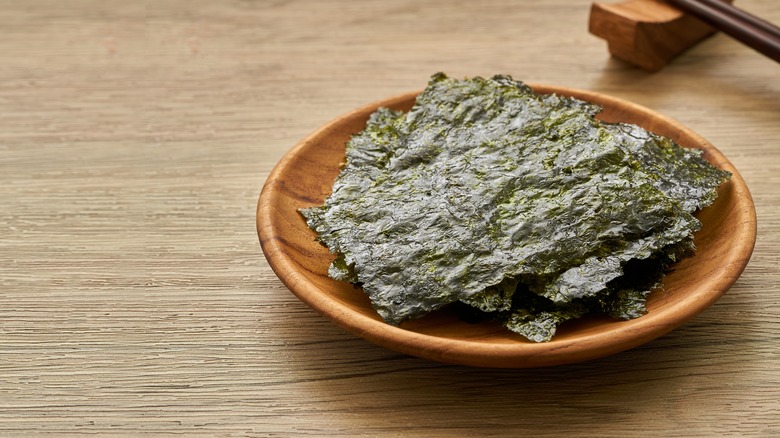8 Under-The-Sea Vegetables You Can Actually Eat
It's no secret that traditional agriculture comes with environmental concerns. As the World Economic Forum reports, industrial agriculture falls short of the needs of the world's growing population, while also harming the environment through pesticide use, water overuse, and habitat destruction. However, more and more, experts are turning to a key and underutilized resource to find solutions — the ocean.
The ocean, the World Economic Forum goes on to detail, can be used for underwater farming, and also cultivating and harvesting edible plants such as kelp and seaweed that already grow beneath the waves on their own. The National Oceanic and Atmospheric Administration further notes that seaweed and kelp, in addition to being tasty, can improve water quality when properly maintained, as seaweed farms absorb carbon dioxide, nitrogen, and phosphorus. In other words, underwater farming of these under-sea vegetables is a big win for the environment.
But whether you want to add an eco-friendly veggie to your plate or just expand your palate, what are the top under-the-sea vegetables you can actually eat? Check out these eight options.
1. Carrageen moss
Sometimes also known as Irish moss, carrageen moss may be unfamiliar in your kitchen, but it's certainly nothing new. The Irish were enjoying this tasty, readily available, and nutritious moss as early as the 1800s, according to Smithsonian Magazine. The moss is technically a branching alga and grows in rocky spots and estuaries along European shores, as well as in North America and Asia. If you're not in a place to harvest your own, you can buy dried carrageen moss and rehydrate it. One traditional use for the moss is carrageen moss pudding. Once rehydrated, boil the now slippery-smooth reddish sea veggie in milk, before discarding, then combine the carrageen moss-infused milk with an egg yolk, sugar, and whisked egg white. After refrigeration for a few hours, it turns into carrageen moss pudding.
According to Irish Central, carrageen moss is filled with good stuff like vitamins A, E, F, and K, as well as potassium, iodine, and calcium. In the past, it's been used to treat coughs and colds, but has also found a place in lotions and skin creams used to help with conditions such as psoriasis.
2. Dulse
Compared to sea vegetables like carrageen moss that are firmly rooted in folklore and old remedies, dulse is relatively new, at least in the United States. In fact, as Oregon State University reported, a new strain of the red marine algae was patented by university researchers in 2015. What makes the 2015 strain special is that it grows incredibly fast — and tastes remarkably like bacon. In the wild, however, dulse grows around oceanic coastlines and has a salty, umami flavor. When dried, it's both eaten and used medicinally.
Depending on where you live, dulse — any variant — may be difficult to find. As of 2015, the Oregon State University researchers said there were no commercial farms producing dulse for food in the country. However, it's far more common in northern Europe. Thanks to its high nutritional value (twice that of kale), dulse is often used in smoothies or added as a topping for its salty flavor. Food & Nutrition recommends chopping and frying dulse leaves to create a bacon-like snack.
3. Kombu
Kombu, sometimes called konbu, and referring to several species of edible brown kelp, is most recognizable for its place in Japanese cooking. Kombu grows off-shore in Japan and has been used in the country's cuisine for more than a millennia, as MasterClass explains. However, kombu's impact on the food world goes far beyond just being used as a necessary ingredient for dashi. In the early 1900s, a researcher used kombu to identify and define what we now know as umami. As you might expect, kombu is defined by its umami-rich flavor profile.
Still, even though kombu and umami are intrinsically intertwined in culinary history, MasterClass clarifies there are technically four different types of kombu, with differing flavor profiles, shapes, and sizes. Some of the most popular uses for kombu include dashi, aka the stock in your miso soup, as well as tsukudani, which is kombu simmered in soy sauce and mirin.
4. Wakame
Growing wild in Australia, and farmed in Japan and South Korea, wakame is a vibrantly green marine alga that, like kombu, is frequently used in Japanese cuisine (via MasterClass). Wakame must be rehydrated before use, and then it can be used in soups, salads, and your favorite ramen recipes.
Beyond being a versatile addition to your kitchen, Healthline points out wakame also makes a smart addition to your diet. Low-calorie wakame provides lots of nutrients, including vitamins A, C, E, and K. It also contains tons of iodine, as well as some manganese, folate, magnesium, calcium, phosphorus, iron, and copper. All those nutrients add up to result in potential health benefits such as good thyroid function (although it's important not to consume excessive amounts of iodine as this can have the opposite effect), reduced blood pressure, reduced risk of heart disease, reduced cholesterol, greater protection from certain cancers, and decreased blood sugar.
As you shop for wakame, don't make the mistake of confusing it with nori. A common seaweed used in Japanese cuisine, nori is likewise sold dried, but nori is sold in sheets, while wakame is sold in strips and must be rehydrated for use.
5. Sea beans
Sea beans, sometimes also called sea asparagus, samphire or Salicornia, grow in coastal marshes, including around the North American East Coast. As Florida Atlantic University explains, these beans look more like asparagus than beans, with a straight stem and a tip. In one article tracing the innovative cultivation of sea beans for use in restaurants in South Carolina, Hakai Magazine notes that, while introducing these sea veggies to modern-day diners is a new concept in the States, other countries have been eating sea beans for a while. Whether used in salads, pasta, or omelets, sea beans have found their place in the cuisines of Europe, Asia, and the Middle East.
Today, thanks to efforts like those in Charleston bringing sea beans to the forefront of foodie consciousness, you can find sea beans for sale in coastal cities at farmers markets, says Grist. If you don't live near the coast, you can also order sea beans online or grow them in your garden. Although they pop up naturally in salt water, they don't actually need it to grow.
6. Sea grapes
Sea grapes are exactly what they sound like. They grow in the sea and look like miniature bundles of green grapes. According to an article from Phys.org, while sea grapes may look like grapes, they actually taste more like caviar, hence their other moniker, "green caviar." Whatever you call them, these salty, small orbs are often cultivated in Asia, where they're eaten raw with salads, sushi, or in sauces. Other cultures have yet to jump on the sea grapes train, even though they're incredibly easy to grow and grow quickly, while also offering a large amount of antioxidants in every serving.
If you live in coastal North America, be sure to not mix up "sea grapes" with "seagrapes," which the University of Florida points out are more like actual grapes. The coastal fruits taste and look like muscadine grapes, but are protected by Florida law, which means it's illegal to remove, damage, destroy, or eat them.
7. Sea purslane
Sea purslane falls into the same category as sea asparagus, according to Florida Atlantic University, which called both sea vegetables "halophyte plants." This means they thrive in salt water or salt marshes, and that saltiness carries over into the vegetables' flavor. In studying the way purslane grows, the university detailed how sea purslane and similar plants can remove undesirable elements from water during growth. Although it's currently underutilized, sea purslane is a great high-protein, low-fat, low-cholesterol alternative to traditional vegetables, that also contains lots of vitamins and minerals.
If you can get your hands on sea purslane, Great British Chefs says the vegetable is best cooked simply, with a quick blanch to cook the plant, followed by the addition of either black pepper, lemon, or butter. Added salt is unnecessary, due to the high amount of salt sea purslane already contains. Great British Chefs recommends serving sea purslane as a side dish with seafood, veal, or lamb.
8. Nori
Out of all the under-sea veggies on our list, nori may be the most familiar if you're a sushi fan. As Food Network explains, when you clean, chop, and create a slurry from fresh seaweed, you're well on your way to making nori. Just take the slurry, spread it out thinly, dry it, and toast it, to create the seaweed wrap that's most commonly used in the United States for sushi.
However, you don't have to be making sushi (or even like sushi) to add nori to your cooking. Food Network goes on to show how you can use nori in a variety of ways. Crumble it like a cracker then sprinkle it over different types of Asian noodles, or make gomasio, which is a Japanese condiment that's basically just mixed, crushed nori, sea salt, and sesame seeds. You can sprinkle this over lots of foods, from soups to salads to stir-fries. You can also use nori as a wrap for other cuisines: Food Network suggests rolling nori squares into cones to hold goat cheese and roasted red peppers.
